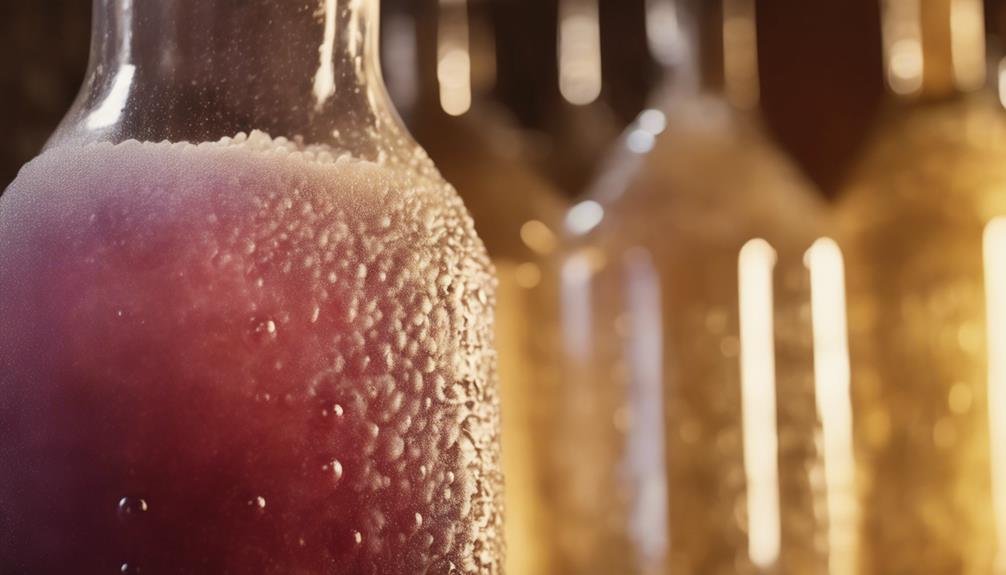Explore the world of sweet wines by understanding residual sugar, which determines sweetness levels. With 10g/L of residual sugar equaling 1% sweetness, winemaking techniques like fermentation timing and yeast selection play vital roles. Factors such as grape type, climate, and consumer taste preferences contribute to the sweetness of wines. Different yeast strains metabolize sugars diversely, impacting final sugar content. Controversy surrounds sugar addition in winemaking, with debates on authenticity and flavor enhancement. Transparent labeling and ingredient disclosure empower consumers to make informed choices. Uncover more about the intricate sweetness of wines beyond their labels.
Understanding Residual Sugar in Wine
In the world of oenology, comprehending the concept of residual sugar in wine is pivotal for discerning the varying degrees of sweetness present in different wine styles. Residual sugar (RS) refers to natural grape sugars left after alcoholic fermentation, measured in grams per liter. For example, 10 g/L of residual sugar equals 1% sweetness.
Yeast consumes sugars during fermentation, affecting the final sugar consumption levels. Sweet wines typically start at around 35 g/L of residual sugar. Different types of wine exhibit varying residual sugar levels, influencing the overall taste profile. Understanding this aspect aids in measuring sweetness and determining sugar consumption in wines, allowing enthusiasts to appreciate the diverse spectrum of flavors in the wine world.
Factors Influencing Sweetness Levels
Understanding residual sugar in wine is not solely dependent on the grape sugars present after fermentation; various factors play a significant role in influencing the sweetness levels of different wine styles. Grape varietals and climate impact the natural sugar levels in grapes, affecting the sweetness of the final product.
Winemaker techniques, such as the choice of yeast, fermentation temperature, and the decision to halt fermentation early, also contribute to the sweetness of the wine. Additionally, consumer preferences play an important role in determining the desired level of sweetness in wines, influencing the winemaking process.
Impact of Yeast Fermentation on Sweetness

Yeast fermentation plays a pivotal role in determining the final sweetness levels of wines, influencing the balance between sugar consumption and residual sugar content.
- Yeast Influence: Different yeast strains can metabolize sugars at varying rates, affecting the amount of residual sugar left in the wine.
- Fermentation Duration: Longer fermentation periods allow yeast to consume more sugars, resulting in drier wines with lower residual sugar levels.
- Temperature Control: Temperature during fermentation impacts yeast activity, affecting sugar consumption and sweetness perception in the finished wine.
- Nutrient Availability: Yeast requires certain nutrients to thrive and efficiently ferment sugars, ultimately influencing the sweetness of the wine.
Understanding these factors is important in comprehending how yeast fermentation can significantly impact the perceived sweetness of a wine.
Controversy Surrounding Sugar Addition
Amidst the intricate world of winemaking, the addition of sugar has sparked contentious debates within the industry. The sugar controversy revolves around the practice of adding sugar to wines, whether for fermentation purposes or to enhance sweetness. Critics argue that sugar addition can mask the true characteristics of the grapes and affect the authenticity of the final product.
Some winemakers defend sugar addition as a way to balance flavors and improve the overall taste profile. Additionally, the use of flavor additives in wine production has also stirred controversy, with concerns about transparency and labeling. While some consumers enjoy flavored wines, others question the purity and integrity of these products.
Ultimately, the debate surrounding sugar addition and flavor additives in winemaking continues to divide opinions in the wine world.
Considerations for Labeling and Transparency

The importance of clear and transparent labeling in the wine industry cannot be overstated. When it comes to labeling transparency, consumer awareness plays a vital role in making informed choices. Here are four key considerations to keep in mind:
- Full Ingredient Disclosure: Guarantee that wine labels provide detailed information about additives and processes used in production.
- Nutritional Information: Including facts like residual sugar content can empower consumers to make healthier choices.
- Certifications and Seals: Look for labels indicating adherence to quality standards or sustainable practices.
- Clarity in Marketing Claims: Transparency in advertising and marketing helps consumers understand the product they are purchasing.
Frequently Asked Questions
Are There Any Health Benefits to Residual Sugar in Wine?
Potential health benefits of residual sugar in wine are limited. While moderate consumption may offer antioxidants, excessive sugar intake can lead to health issues. Taste perception varies, affected by sugar content and winemaking. Regional specialties may influence health implications.
Can Residual Sugar Levels Vary Within the Same Wine Varietal?
Residual sugar levels can indeed vary within the same wine varietal due to factors like grape maturity and winemaking techniques. These variations can impact taste preferences, aging potential, and overall complexity of the wine.
How Do Winemakers Control Sweetness Levels in Wine?
Winemakers control sweetness levels by managing yeast fermentation. They can halt fermentation to retain residual sugar or choose specific yeast strains. Aging techniques like oak barrels can impart sweetness. Monitoring sugar levels throughout the winemaking process is essential.
Is There a Difference in Residual Sugar Perception Between Red and White Wines?
Perception of residual sugar differs between red and white wines due to varying levels and grape varietals. Red wines often have higher tannins masking sweetness, while white wines with lower tannins may showcase sweetness more prominently. Health benefits depend on consumption moderation.
Are There Specific Wine Regions Known for Producing Sweet Wines?
Influential terroirs and unique grape varieties contribute to specific regions producing renowned sweet wines. Exemplary vineyards like Sauternes in Bordeaux and Mosel in Germany showcase exceptional craftsmanship, yielding exquisite dessert wines that captivate connoisseurs globally.
Conclusion
In the world of wine, residual sugar plays a vital role in determining the sweetness levels of different varieties. Understanding the origins and manipulation of residual sugar provides insight into the complex flavors found in wines.
Whether through natural fermentation or controversial sugar additions, the presence of residual sugar impacts the taste profile of wines.
By considering labeling practices and transparency in sugar content, wine enthusiasts and consumers can make informed choices when selecting their preferred sweet wines.